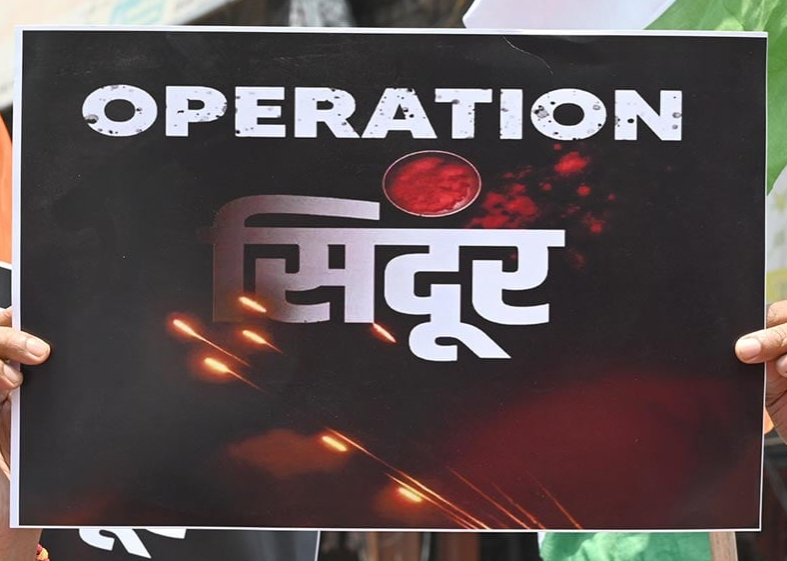Editorial Note: This blog post was written after the operation “Sindoor”
–Written by K. TANUSHRI ,Forum for Global Studies (FGS), India
Email: ktanushri539@gamil.com
22nd April 2025 — A day etched in the collective memory of our nation — marks the tragic loss of 26 innocent civilians, brutally massacred in the serene, snow-clad valleys of Pahalgam. Oblivious to the looming danger, families basked in the scenic beauty of Kashmir — the fresh breeze of summer sweeping through what is fondly known as “Mini Switzerland.” Little did they know that a group of five armed terrorists would turn a cherished holiday into a bloodstained nightmare.
The attack unfolded in Baisaran, an alpine meadow nestled in Pahalgam, where 26 people, including a resident, were mercilessly gunned down. The assailants, identified as members of The Resistance Front (TRF) — a proxy outfit of the notorious Lashkar-e-Taiba (LeT) — carried out one of the deadliest assaults in the recent history of Kashmir. According to eyewitness Macassar, the militants deliberately singled out men, asked their names, and executed them on the spot.
The victims predominantly included Hindu men and one Christian. Condemning the massacre, the Chief Minister of Jammu and Kashmir described the perpetrators as “inhuman, barbaric, and utterly despicable.” Nationwide outrage erupted. A unified voice echoed nationwide demanding justice, and the government responded swiftly. Under the Prime Minister’s and Cabinet’s leadership, India initiated what Defence Minister Rajnath Singh called a “decisive and robust retaliation.”
All land borders shared with Pakistan were sealed, and security was heightened. Visa services for Pakistani citizens were suspended. Pakistani High Commission officers serving as military advisors in India were expelled. Most significantly, India suspended the Indus Waters Treaty — a bold diplomatic move signalling a severe deterioration in bilateral relations. India has set a new precedent for Pakistan, an approach never used before. These decisions sent a message: “India will not back down”.
OPERATION SINDOOR :
— The terror of April 22 did not dissipate easily; India took it personally. The attack was a calculated attempt to incite communal tensions within the country, aiming to fracture societal harmony along religious lines. India responded with unwavering resolve and strategic precision through “Operation Sindoor.”
In the early hours of May 7, while the nation slept, the Indian Armed Forces executed a series of coordinated strikes against terrorist infrastructure in Pakistan and Pakistan-occupied Kashmir (PoK). Nine sites were meticulously targeted, including locations in Muzaffarabad, Kotli, Bhimber, and Punjab provinces. These strikes aimed to dismantle the operational capabilities of terrorist groups responsible for the Pahalgam attack.
The operation resulted in the elimination of over 100 terrorists, including high-value targets such as Yusuf Azhar, Abdul Malik Rauf, and Mudasir Ahmed, who were implicated in previous attacks against India. India maintained a focused approach, ensuring that civilian areas were not affected, thereby demonstrating a commitment to ethical conduct even amidst retaliation.
Pakistan’s response included aggressive shelling and drone incursions targeting Indian civilian areas, leading to casualties and infrastructural damage. Despite these provocations, India upheld its stance of strategic restraint, emphasizing its readiness to defend its sovereignty while avoiding unnecessary escalation.
Operation Sindoor showcased India’s decisive military response and marked a historic national defence narrative moment. Two exemplary women officers—Colonel Sofiya Qureshi of the Indian Army and Wing Commander Vyomika Singh of the Indian Air Force—stood at the forefront, co-leading the official briefing on the operation alongside Foreign Secretary Vikram Misri. Colonel Qureshi, a third-generation military officer from Vadodara, has a distinguished career leading a multinational military exercise and serving in UN peacekeeping missions. Her leadership during the briefing exemplified the increasing trust in female officers within the Indian Army.
Wing Commander Singh, hailing from Lucknow, is a seasoned helicopter pilot with extensive experience in high-risk terrains. Her role in presenting Operation Sindoor underscored her pivotal position in the Indian Air Force during critical national security operations.The nation stands united in saluting the Indian Armed Forces—the brave men and women who placed their lives on the line to uphold justice and national security. Their precision, professionalism, and moral clarity have avenged the innocent and reminded the world that India is a land of peace, but never of passive silence. The uniform they wear is more than fabric; it is the promise of protection, resilience, and unwavering patriotism.
Prime Minister, Narendra Modi in his address to the nation, says, “we remain committed to taking strong steps to safeguard india and its people. Operation Sindoor has added a new dimension. The Operation and the nation’s approach towards the situation did get criticism; a few were worried the situation might escalate into an unending war between the countries. A ceasefire, however, was signed with the US as the mediator. Pakistan soon violated the truce, causing india to take necessary action in self-defence. OPERATION SINDOOR , symbol of India’s strength, not only protected the nation, but also set a much-needed standard for India’s readiness to fight cross–border terrorism against all odds.
Disclaimer “The authors are solely responsible for the authenticity of the facts and figures mentioned. FGS is merely a platform provider and does not endorse or express any opinion on the content.”

